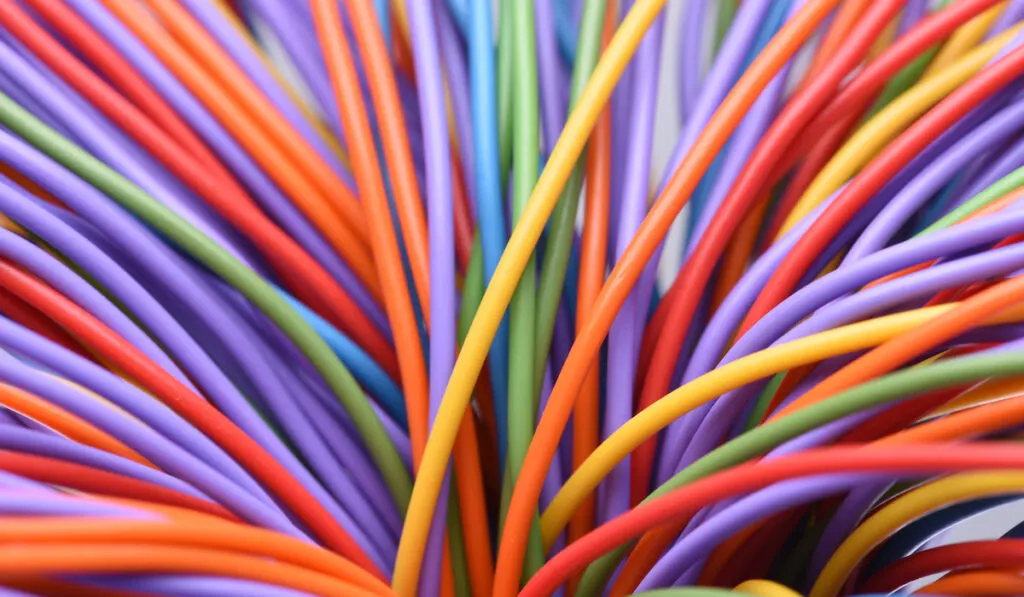*This post may have affiliate links, which means I may receive commissions if you choose to purchase through links I provide (at no extra cost to you). As an Amazon Associate, I earn from qualifying purchases. Please read my disclaimer for additional details.
Cloth wiring was made by weaving cotton strands impregnated with rubber around electrical cables. It was a popular and inexpensive method for home electrical wiring in the mid-twentieth century but is rarely found today.
Because it no longer meets fire safety regulations, it’s now considered a fire hazard.

Table of Contents
Is Cloth Wiring Dangerous?
Cloth wiring doesn’t meet current fire safety codes, so Yes! It is considered dangerous.
Here are a few reasons why cloth wiring is considered a fire hazard:
- It’s highly flammable. Since cloth layers are directly woven over the bare wire, any spark may easily ignite the cloth fibers.
- Cloth can fray over time and result in exposed wires. If exposed wires come into contact with each other they can cause sparks and fires.
- Cloth wiring is also more susceptible to rodent and insect damage, hence it’s a safety risk.
- Modern homes use much more power than in the past and this archaic wiring can’t keep up with the increased load. Overloading causes excessive heat and your house wiring can break down completely because of it.
- It does not come with circuit breakers, instead, a fuse box is used, typically without grounding. Modern grounding methods save you from potential circuit breakdowns and sudden power surges.
When and Why Was Cloth Wiring Used?
Cloth wiring originated in the 19th century, well before plastic-coated wires were even invented.
It used multiple layers of fabric over bare copper wires, which worked well as insulation. Soon, cloth wiring became common in American houses due to its low cost and ease of installation.
Early in its manufacturing, cloth wiring used asbestos paper for its durability and heat resistance properties. The use of this material was stopped when the harmful effects on human health were realized. Later on, a layer of rubber-impregnated fabric was used as the outermost covering, which is the type most often uncovered in old houses during restoration.
It was only after the 1960s that plastic coated wiring came into the picture. The plastic material was cheap, readily available, and had much better safety properties than cloth as a wire covering. So, modern plastic-coated wire became the standard soon after.

Does Cloth Wiring Contain Asbestos?
In the early twentieth century, asbestos paper, which is a serious health hazard, was used to line cloth wiring.
However, not all wiring systems from the past have an asbestos lining. This method was discontinued early in the 1900s and most houses with cloth wiring nowadays don’t have asbestos.
Instead, you will find oil-clad cloth wiring or rubber-cloth insulation along with other materials.
If you suspect your house wiring has asbestos, have it tested by a safety professional. If the testing comes out as positive, hire experts to carefully remove this dangerous material.
Can You Get a Homeowner Insurance On a House With Cloth Wiring?
The insurance policy for homes with cloth wiring depends on your state’s laws, your insurer, and your home inspection. Some states still allow homes with cloth wiring to have insurance if it is in good condition and has been inspected by an electrician.
States like Florida have a “4 points inspection” policy. Old homes must pass this inspection before they can qualify for insurance.
Insurance companies may refuse to insure a home with cloth wiring, but policies largely vary among insurers. It does not disqualify you instantly but companies will need an evaluation by an electrician who determines the condition and safety of the cloth wiring.
Even with cloth wiring in good condition, there is a chance that your insurance company will refuse to insure your home or they may want a higher premium.
Should You Buy a House With Cloth Wiring?
It’s better not to invest in a house with cloth wiring. But if you are still interested in the house, make sure to get it evaluated by an electrician and have him inspect the entire property for safety before you commit.
Otherwise, you will need to put in lots of effort and budget for new wiring and insurance. Even if the house’s wiring system looks functional, it can have a multitude of hidden electrical problems. Such as frayed circuits and the potential to overheat.
If you have to purchase a house with cloth wiring, get a rewiring estimate from an electrician and ask for deductions in price as compensation. After all, you don’t want to use your savings or rack up debts for a property that could potentially be unsafe.

Should You Replace Cloth Wiring (and Will it be Expensive?)
For the safety of your house and your family, it is recommended to replace cloth wiring when possible. Have newer plastic-coated electrical wiring with proper grounding and safety measures.
Along with increased safety, plastic coated wiring has many more benefits including:
- It’s user-efficient, and can save on your energy bill
- Easy to repair or extend
- It’s easier to get house insurance with modern wiring
Depending upon the size of your house, your local electrician’s rate, and the availability of the material in your area you should expect anywhere between $1000 to $10,000 for completely rewiring your home.
Bottom Line
Homeowners should carefully evaluate the safety risk involved with cloth wiring and decide to rewire accordingly. It is recommended to replace cloth wiring when possible.
However, if replacing it is not an option (as in you are selling your house), then cloth wiring must be inspected and tested regularly. It’s best to hire a professional electrician for these safety checks.
Sources
- https://homecheckfl.com/cloth-wiring/
- https://www.whittinspections.com/homeowner-resources/cloth-wiring/
- https://alphabuildinginspections.com/cloth-wiring/
- https://pennaelectric.com/electrician-blog/what-is-cloth-wiring-why-you-shouldnt-have-it/
- https://www.houzz.com/discussions/3705240/old-cloth-covered-wiring-should-i-have-it-replaced
- https://waypointinspection.com/cloth-covered-wires/
- https://homeguide.com/costs/cost-to-rewire-a-house
- https://diy.stackexchange.com/questions/153861/household-wire-insulation-asbestos-risk
- https://askinglot.com/does-cloth-covered-wire-contain-asbestos
